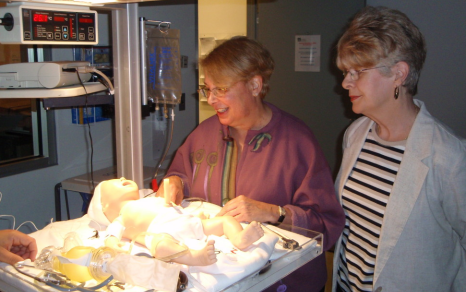SimBaby allows PICU residents, nurses and technicians to train for crises

The six-month-old baby was rushed to the Pediatric Intensive Care Unit (PICU) from the Emergency Department with a fever, erratic respiration, dangerously low blood pressure and a high heart rate. Scot T. Bateman, MD, clinical associate professor of pediatrics, stood at the foot of the small bed and called a “code.” Suddenly, a half dozen doctors, nurses and critical care technicians appeared in the room, crowding around the small bed to ask questions and assess vital signs as they began their attempt to save the child’s life.
The activity in the room was frenetic and loud, yet controlled: each person knew his or her role in tending to the child. Instructions were called out, acknowledged and performed; supplies were requested and delivered; monitors beeped insistently and their readings were called out as the team worked quickly but methodically to stabilize the child.
Dr. Bateman called out suddenly, “Stop! You’re done. Good job, another life saved.”
This was all only a drill, and the infant at the center of all this activity was SimBaby, a full-body infant mannequin with realistic anatomy and clinical functionality that incorporates software and interactive technology, giving learners the opportunity to safely practice the emergency treatment of patients. After Bateman called an end to the code, the team gathered around him to discuss the drill—not only the procedures they used and the care they delivered, but, importantly, how they communicated and how well the team worked together. The safe environment of the drill allows them to ask questions and make suggestions without the pressure of a real life-and-death situation.
Bateman and PICU attending physician Jennifer Thompson, MD, assistant professor of pediatrics, facilitate a SimBaby code every Tuesday morning to give residents and nurses alike the opportunity to practice emergency care and hone the skills they will employ when their real patients need urgent care.
“These Tuesday morning drills are invaluable because real codes are, thankfully, very rare,” said Bateman. “With SimBaby, the whole team gets to train on a specific scenario”—in this case, the “child” was suffering from sepsis—“and build their skills and gain confidence in how they will act in a real situation.”
Carol Kronopolus, RN, associate professor of nursing and a nurse specialist educator for UMass Memorial Medical Center, values the drills because they are realistic. “Caregivers really respond to the mannequin as if it is a real child,” said Kronopolous. “Having these drills here in the PICU enhances the lesson and even helps us see areas where we could improve what we do—for example, are all of the necessary supplies at hand? What else can we do to prepare ourselves to deliver this care?”
One of the key teaching tools of the UMass Medical School Simulation Center, SimBaby was a gift from the Paul C. and Gladys W. Richards Charitable Foundation. Roberta Carlin and Linda Arman, trustees of the foundation, have been supporting the Simulation Center for a number of years, funding the purchase of not only SimBaby and SimNewB (a newborn version), but also Harvey, an adult-sized mannequin that replicates the physical symptoms of more than 30 cardio-pulmonary conditions to aid in the teaching and assessment of cardio-pulmonary bedside diagnosis.
“This is why we bought them—to help future doctors and nurses learn,” said Carlin, who has visited the SimCenter with Arman several times to watch students training with the mannequins. “The technology is fascinating, and we’re really delighted to be able to support medical education this way.”
Michele P. Pugnaire, MD, senior associate dean of educational affairs and interim director of the Simulation Center, said of SimBaby and its family of mannequins, “I would love to have more. I can’t say enough about how important these sophisticated tools are in medical education and in continuing professional education. They provide our students, residents, physicians, nurses and all health care professionals with the opportunity to teach each other, practice in teams and learn from our mistakes in a safe and controlled environment, with our ultimate goal being the best quality health care for our patients.”